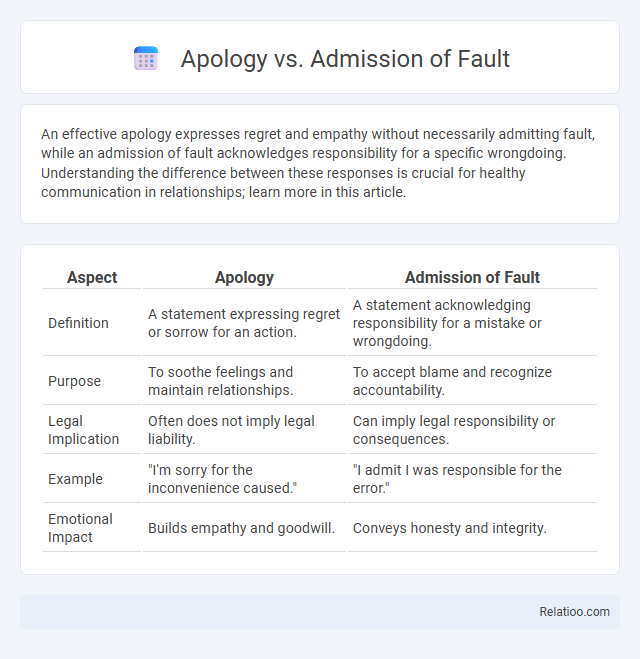An effective apology expresses regret and empathy without necessarily admitting fault, while an admission of fault acknowledges responsibility for a specific wrongdoing. Understanding the difference between these responses is crucial for healthy communication in relationships; learn more in this article.
Table of Comparison
| Aspect | Apology | Admission of Fault |
|---|---|---|
| Definition | A statement expressing regret or sorrow for an action. | A statement acknowledging responsibility for a mistake or wrongdoing. |
| Purpose | To soothe feelings and maintain relationships. | To accept blame and recognize accountability. |
| Legal Implication | Often does not imply legal liability. | Can imply legal responsibility or consequences. |
| Example | "I'm sorry for the inconvenience caused." | "I admit I was responsible for the error." |
| Emotional Impact | Builds empathy and goodwill. | Conveys honesty and integrity. |
Understanding Apology vs Admission of Fault
Understanding the difference between an apology and an admission of fault is crucial in communication and conflict resolution; an apology expresses regret or sorrow for an action or its impact without necessarily accepting blame, while an admission of fault explicitly acknowledges responsibility for a mistake or wrongdoing. Apologies often emphasize empathy and repairing relationships, whereas admissions of fault can have legal or professional implications, potentially affecting liability or accountability. Recognizing this distinction helps individuals and organizations navigate disputes more effectively by choosing language that aligns with their intent and desired outcomes.
The Psychology Behind Apologizing
The psychology behind apologizing reveals that an apology serves as a social tool to acknowledge a mistake without necessarily admitting full fault, allowing for repair of relationships and restoration of trust. Admissions of fault involve recognizing personal responsibility, which can trigger feelings of vulnerability and impact one's self-esteem, while offenses focus on the emotional impact felt by the injured party. Understanding these distinctions empowers you to communicate more effectively, fostering empathy and resolution in interpersonal conflicts.
Legal Implications: Apology vs Admission
Apology in legal contexts often expresses sympathy without conceding liability, allowing parties to maintain their defense while fostering goodwill. Admission of fault legally acknowledges responsibility, potentially resulting in increased liability and being used as evidence in court proceedings. Understanding the distinction is crucial, as apologies typically do not waive legal protections, whereas admissions can directly impact the outcome of litigation.
Communication Strategies: Choosing the Right Approach
Effective communication strategies require understanding the distinctions between apology, admission of fault, and offense to navigate conflicts appropriately. An apology addresses emotional repair without necessarily conceding blame, while an admission of fault acknowledges responsibility, which can impact legal or relational outcomes. Your choice influences resolution dynamics, so selecting the right approach depends on the context, audience expectations, and desired outcome in conflict management.
Cultural Perspectives on Apologies and Fault
Cultural perspectives shape how apologies, admissions of fault, and offenses are perceived and expressed across societies, influencing communication and conflict resolution. In some cultures, an apology serves as a delicate gesture to restore harmony without explicitly admitting fault, while others expect a direct admission as a sign of accountability. Understanding these nuances helps you navigate intercultural interactions effectively, respecting different values and expectations around responsibility and reconciliation.
Impact on Relationships and Trust
An apology demonstrates empathy and a willingness to reconcile, often restoring trust and strengthening relationships by acknowledging the other party's feelings. An admission of fault goes further by accepting responsibility, which can deepen trust but may also increase vulnerability depending on the context. Offense, without acknowledgment or apology, tends to damage relationships and erode trust, creating emotional distance and potential conflict.
Corporate and Professional Contexts
In corporate and professional contexts, an apology serves as a strategic communication tool that acknowledges a mistake without necessarily conceding blame, helping to preserve relationships and company reputation. An admission of fault explicitly accepts responsibility for an error, which can have legal and financial implications for your organization. Offense, often perceived as a personal affront, can escalate conflicts and damage professional trust if not managed carefully through clear, composed responses.
Apologies Without Admission: Pros and Cons
Apologies without admission of fault allow individuals or organizations to express regret and offer empathy without legally admitting liability, reducing the risk of lawsuits or increased insurance costs. This approach can preserve relationships and demonstrate goodwill while maintaining a defensive stance, but it may also be perceived as insincere or evasive, potentially undermining trust and resolution. Balancing the benefits and risks of non-admittance apologies requires clear communication strategies and understanding of the legal and social context.
When an Admission of Fault Is Necessary
An admission of fault is necessary when legal accountability or trust restoration depends on clear acknowledgment of wrongdoing, especially in contractual disputes or personal injury cases. Unlike a general apology, which expresses regret without confirming liability, an admission of fault explicitly accepts responsibility, impacting settlement negotiations and insurance claims. In contexts where offense alone is caused, an admission of fault may not be required unless it leads to tangible damages requiring formal redress.
Crafting an Effective Apology Statement
Crafting an effective apology statement involves clearly distinguishing between an apology, which expresses regret for causing hurt, and an admission of fault that acknowledges responsibility for the mistake. Your apology should concentrate on empathizing with the offended party, addressing the offense specifically, and offering a sincere commitment to prevent recurrence. Using precise language that separates regret from blame enhances the apology's impact and fosters constructive resolution.

Infographic: Apology vs Admission of Fault
 relatioo.com
relatioo.com